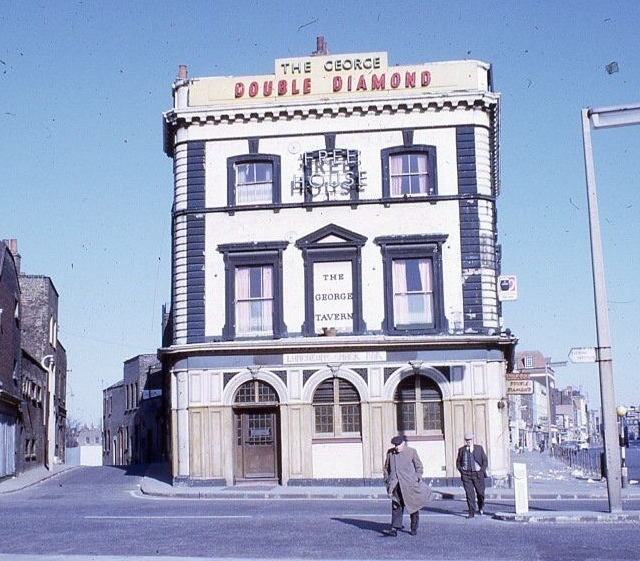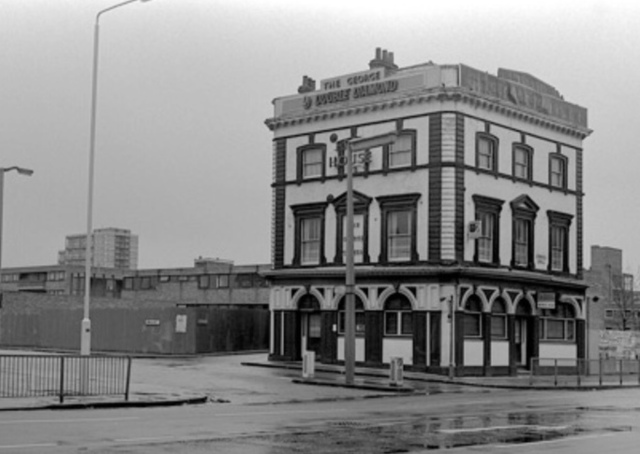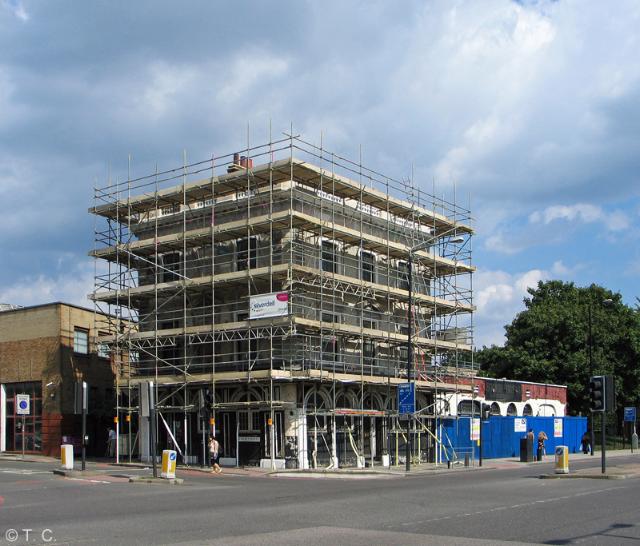» Main Index

» Search This Site

» Submit Update

» Contact Us


|
|

|
Home > London >
E1 > George Tavern
George Tavern

|
|
Picture source:
Timothy Keane |
|
|
|
|
The George Tavern was situated at 373 Commercial
Road. This grade-II listed pub closed c2013. |
|
|
|
Now reopened. |
|
Francesca Capra (January 2015) |
|
|
|
|
|
|
Listed
building details: |
Public house, with accommodation
above. Built in the early C19 approximately on site of an earlier pub, the
Halfway House. Remodelled 1862, probably by James Harrison. Ground-floor pub
interior remodelled 1891 by RA Lewcock. The 3-storey pub on corner site is
of primary interest, with 2-storey range continuing along Aylward Street.
Exterior: Corner building with 2 principal elevations to Jubilee Street (W)
and Commercial Road (S). Brick (now painted) with stucco dressings,
modillion cornice under balustraded parapet in front of M-roof. Doors and
windows to pub front set in continuous arcade with round-headed arches
separated by panelled pilasters, with 3 bays to W elevation and 4 to E, the
last bay with a broader, elliptical arch. Arches have decorative floral
motifs in bas relief, keystones and cast-iron openwork spandrels. Bracketed
cornice above ground floor. Above this, the elevations are identical, each
with 3 windows; those to first floor with moulded architraves and bracketed
pediments; second-floor windows with architraves and keystones, centre W
window blank. String course at 2nd floor sill height. To Aylward Street
return, a single bay as at front and then plainer detailing with single door
in plain doorcase, rendered ground floor under plat band, and rebuilt
brickwork above. East of this, 2a continues as lower two-storey range with
blind windows and 1884 and 1843 parish boundary stones that indicated the
boundary relative to 'The George'. Attached to east on Commercial Road, the
single-storey range: 'Stepney Night Club', is not of special interest.
Interior: Ground-floor pub plan has been opened up, with a modern bar in a
traditional style. Cast-iron columns with foliated capitals. E wall has good
series of tiled panels, including a painted scene of Halfway House titled
'Ye George Tavern in Ye Olden Times 1654; Classical scenes with putti, and
'The George', framed with Art Nouveau-style tiles. Cellar has brick-lined
passage with shallow barrel-vaulted ceiling and slate shelves in side
niches.
Features which are likely to be survivals from the early-C19 building
include a well stair with slender turned newels (balusters replaced), and
first-floor doors with panelled linings and fluted architraves with lion
masks to corners. Also, uncovered patches of wallpaper in early-C19
neo-classical style to first-floor landing. 3 marble Victorian fireplaces.
Panelled window shutters.
History: The George Tavern and 2a Aylward Street were built approximately on
the on the site of the Halfway House, believed to be of mid-C17 origin. Map
evidence shows that the Halfway House was rebuilt in the C18, after 1745,
approximately 50m to the north east of the earlier inn. The present building
was built between 1799 and 1819. The trapezoidal footprint of a corner
building, with the annotation 'George', appears on William Faden's Fourth
Edition of Horwood's Plan (1819). The building also appears on Greenwood's
map of 1827. The pub therefore forms part of the development of Commercial
Road, which was created following the Commercial Road Act of 1802 to link
the newly-built East and West India Docks to the City boundary. Maps suggest
that 2a Aylward Street was built around the same time as the George pub,
possibly as a stable or other service accommodation; there was originally a
yard to the rear of the pub, but this has been built over. It is unclear
whether the vaults, which are mainly beneath the 2-storey range, date from
the earlier inn or the early C19.
Sources: Pevsner, The Buildings of England, London 5: East, p 527 M Girouard
(1984), Victorian Pubs English Heritage (1984), Pubs: Understanding Listing
English Heritage (2004), Licensed to Sell
Reasons For Designation: The George Tavern is listed at Grade II for the
following principal reasons: * A handsome corner public house with
well-detailed Italianate elevations of 1862, which has strong townscape
interest * Retention of earlier features from remodelled early-C19 building
* Fine ornate tiling to bar, presumed to date from the 1891 remodelling *
Group value with Nos 300 to 334 (even) opposite * Of historic interest as a
reminder of the use of the site as an inn, possibly since the C17, and as
part of the early C19 development of Commercial Road, an important historic
thoroughfare from the Docklands to the City |
|
|
|
Do you have any anecdotes, historical information, updates or photos of this pub? Become a contributor by submitting them here.
You can also make email contact with other ex-customers and landlords of this pub by adding your details to this page. |
|
|
|
Other Photos |
 |
|
Picture source:
Timothy Keane |
 |
|
Picture source: T C |
|
|